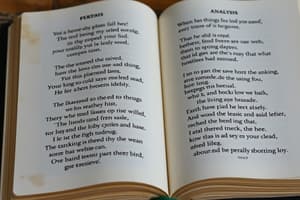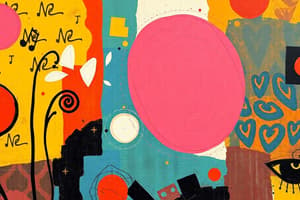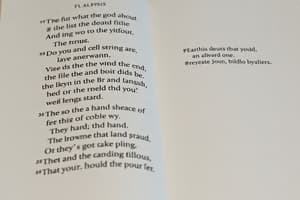Podcast
Questions and Answers
Which element of poetry involves the use of the five senses to intensify the impact of words?
Which element of poetry involves the use of the five senses to intensify the impact of words?
- Rhyme
- Tone
- Imagery (correct)
- Rhythm
A spondee in poetry consists of an unstressed syllable followed by a stressed syllable.
A spondee in poetry consists of an unstressed syllable followed by a stressed syllable.
False (B)
What is the term for a stanza consisting of three lines?
What is the term for a stanza consisting of three lines?
tercet
The figure of speech where a part is used to represent the whole is known as ______.
The figure of speech where a part is used to represent the whole is known as ______.
Match the following figures of speech with their descriptions:
Match the following figures of speech with their descriptions:
The term 'literature' originates from the Latin word meaning:
The term 'literature' originates from the Latin word meaning:
The Epic of Gilgamesh is considered one of the earliest known literary works.
The Epic of Gilgamesh is considered one of the earliest known literary works.
What is the purpose of literature that involves reflecting issues in society, such as in 'Holiday' by Green Day?
What is the purpose of literature that involves reflecting issues in society, such as in 'Holiday' by Green Day?
The Classical Period of Literature, also known as the Golden Age, primarily focused on ______ and Clarity.
The Classical Period of Literature, also known as the Golden Age, primarily focused on ______ and Clarity.
Match the author with their work from the Classical Period:
Match the author with their work from the Classical Period:
In the Medieval Period, literature primarily focused on:
In the Medieval Period, literature primarily focused on:
Allegory, meaning hidden meaning, was not a prominent feature in the Medieval Period.
Allegory, meaning hidden meaning, was not a prominent feature in the Medieval Period.
What historical event is associated with the beginning of the Renaissance period in literature?
What historical event is associated with the beginning of the Renaissance period in literature?
The Enlightenment Period, also known as the Neoclassical Period, emphasized ______, order, and structure.
The Enlightenment Period, also known as the Neoclassical Period, emphasized ______, order, and structure.
Match the author with their work from the Enlightenment Period:
Match the author with their work from the Enlightenment Period:
Which of the following is a characteristic of Romanticism?
Which of the following is a characteristic of Romanticism?
The Victorian Period focused on fantastical elements and abstract concepts rather than daily life and realistic problems.
The Victorian Period focused on fantastical elements and abstract concepts rather than daily life and realistic problems.
What is a key characteristic that defines literature of the Modern Period, starting in the 20th century?
What is a key characteristic that defines literature of the Modern Period, starting in the 20th century?
The Post Modern Period is also known as the Period of ______.
The Post Modern Period is also known as the Period of ______.
Match the author with their work from the Post Modern Period:
Match the author with their work from the Post Modern Period:
Flashcards
Persona
Persona
The speaker or voice of the literature.
Tone
Tone
The attitude of the voice in the literature; influences the mood through word choice and descriptions.
Mood
Mood
The setting or atmosphere of the literature.
Imagery
Imagery
Signup and view all the flashcards
Rhythm
Rhythm
Signup and view all the flashcards
Stanza
Stanza
Signup and view all the flashcards
Rhyme
Rhyme
Signup and view all the flashcards
Theme
Theme
Signup and view all the flashcards
Simile
Simile
Signup and view all the flashcards
Metaphor
Metaphor
Signup and view all the flashcards
Personification
Personification
Signup and view all the flashcards
Synecdoche
Synecdoche
Signup and view all the flashcards
Metonymy
Metonymy
Signup and view all the flashcards
Hyperbole
Hyperbole
Signup and view all the flashcards
Understatement
Understatement
Signup and view all the flashcards
Paradox
Paradox
Signup and view all the flashcards
Oxymoron
Oxymoron
Signup and view all the flashcards
Allusion
Allusion
Signup and view all the flashcards
Literature
Literature
Signup and view all the flashcards
Allegory
Allegory
Signup and view all the flashcards
Study Notes
- Summary of key elements, figures of speech, introduction, and a timeline of world literature.
Elements of Poetry
- Persona refers to the speaker within the literary work.
- Tone is the attitude conveyed by the voice in the literature, influencing the mood through word choice and descriptions.
- Mood constitutes the setting of the literature, shaping the atmosphere.
- Imagery involves appealing to the five senses to intensify the impact of words and establish a particular mood.
- Types of imagery include:
- Visual: appeals to sight
- Auditory: appeals to hearing
- Olfactory: appeals to smell
- Gustatory: appeals to taste
- Tactile: appeals to touch
- Rhythm is created by the pattern of stressed and unstressed beats or syllables.
- Syllables are units of rhythm:
- Stressed syllables (S) receive more emphasis.
- Unstressed syllables (US) receive less emphasis.
- Common patterns:
- Iamb: US/S
- Trochee: S/US
- Spondee: S/S
- Dactyl: S/US/US
- Anapest: US/US/S
- A stanza is a group of lines forming a division in a poem.
- Types of stanzas:
- Couplet: 2-line stanza
- Tercet: 3-line stanza
- Quatrain: 4-line stanza
- Cinquain: 5-line stanza
- Sestet: 6-line stanza
- Rhyme is the repetition of similar sounds.
- Theme is the main idea or underlying message of the poem.
Figures of Speech
- Simile makes a comparison using "like" or "as."
- Metaphor makes a direct comparison without using "like" or "as."
- Personification gives human characteristics to inanimate objects
- Synecdoche uses a part to represent the whole.
- Example: "I got new wheels" (referring to a car).
- Metonymy replaces the name of an object with a related word.
- Example: "I was riding shotgun" (referring to the front seat of the car).
- Hyperbole involves exaggeration.
- Example: "I'm so hungry I could eat a cow."
- Understatement downplays the reality of a situation.
- Example: "I don't like your little games" (said in response to something serious).
- Paradox presents something that seems contradictory.
- Example: "I never heard silence quite this loud."
- Oxymoron combines contradictory terms.
- Example: "Jumbo shrimp."
- Allusion references a well-known person, place, or event.
- Example: Kendrick says "Sometimes you gotta pop out and show."
Intro to World Literature
- Literature is body of written work
- Originated from the Latin word "Litaritura/Litteratura," which means "writing formed with letters".
- World literature encompasses all books and writing, regardless of origin, according to Europeans.
- Literature originated in the Southern Region of Mesopotamia, also known as Sumer.
- Early literary works often served a religious purpose known as didactic.
- Enheduanna (2285-2250 BCE), a high priestess of Ur, is recognized as the first author, who composed hymns dedicated to the Sumerian goddess Inanna.
- The Epic of Gilgamesh (c. 2150 BCE) stands as one of the earliest known literary works.
- The purpose of literature:
- Offers entertainment by transporting us to different worlds or real-life scenarios.
- Serves as a tool for education and learning.
- Provides Social Commentary, reflecting on societal issues.
- Facilitates Self-Discovery by learning about personal values.
- Establishes Emotional Connection by evoking empathy and fostering connection.
Timeline of Literature
-
There are eight major periods of literature.
-
1st Period: Classical Period/Golden Age
-
Emphasizes common sense and clarity.
-
Focuses on epics and prose.
-
Notable authors and works:
-
Homer: Iliad and Odyssey
-
Aristotle: Poetics
-
Ovid: Metamorphoses
-
2nd Period: Medieval Period (aka the Dark Age)
-
Focuses on art and history.
-
Literature centers on the lives of saints and prayers due to the religious context.
-
Allegory is prominent, using hidden meanings.
-
Notable authors and works:
-
Digenis Acritas (anonymous Greek author)
-
Beowulf (anonymous Anglo-Saxon author)
-
Cantigas de Santa Maria (Galician authors)
-
Authors remained anonymous due to religious persecution
-
3rd Period: Renaissance (aka The Rebirth)
-
Focuses on Greek classical values and art
-
Started with Martin Luther's opposition to the Church in the 16th century.
-
Religion was still prominent, but not the primary focus, leading to the exploration of new ideas.
-
Notable authors and works:
-
Shakespeare: Hamlet
-
Petrarch: Canzoniere
-
Boccaccio : Decameron
-
Miguel de Cervantes: Don Quixote
-
4th Period: Enlightenment Period (aka Neoclassical Period, aka: New Classical)
-
Emphasizes common sense, order, accuracy, and structure.
-
Focuses on conservatism, self-control, grammar, and etymology
-
Notable authors and works:
-
Jonathan Swift: Gulliver's Travels
-
Daniel Defoe: Robinson Crusoe
-
John Milton: Paradise Lost
-
John Dryden: To my lord chancellor and marriage a la mode
-
5th Period: Romantic Period (aka Romanticism)
-
Not focused on love Six Characteristics of Romanticism:
-
Focuses on nature and spirituality
-
Isolation and Melancholy
-
Interest in the common man
-
Idealization of women
-
Personification and Pathetic Fallacy
-
Emotion and Imagination
-
Authors in the period:
-
John Keats
-
William Wordsworth - The Prelude
-
Percy Bysshe Shelly
-
Mary Shelley
-
6th Period: Victorian Period & 19th Century, Era of Realism
-
Focuses on daily life and practical problems, talks about realistic problems
-
Age of Doubt and Contradictory faiths and philosophies
-
Idealistic Age where the great ideals like truth, justice, love, brotherhood are emphasized by poets, essayists and novelists of the Age.
-
Social issues
-
Authors in this period:
-
Elizabeth Barrett Browning
-
Robert Browning
-
Charles Dickens - A Tale of Two Cities
-
7th Period: Modern Period (aka Period of Experimentation)
-
Talks about Experimentation and Individualism, which Started with the 20th Century
-
Supposed to talk about Surrealism, Stream off Consciousness, Symbolism, and Expressionism
-
Authors in the period are:
-
David Herbert Lawrence, Sons and Lovers
-
James Joyce, Ulysses
-
Thomas Stearns Eliot, Murder in the Cathedral
-
8th Period, Post Modern Period, aka Period of Metafiction
-
Explores beyond the earth, like out of this world like unicorns, focuses on unusual forms of artistic expression, like abstract art
-
Talks about the sadness and the meaninglessness after World War 2
-
Distinction between high and low culture; they mix genres in a single work such as Romantic Comedy
-
Linked Philosophical and Psychological questions
-
Authors in this period are:
-
John Barth - The Literature of Exhaustion
-
Samuel Beckett - Theatre of the Absurd
-
Italo Calvino - If on a winter’s night a traveler
Studying That Suits You
Use AI to generate personalized quizzes and flashcards to suit your learning preferences.




